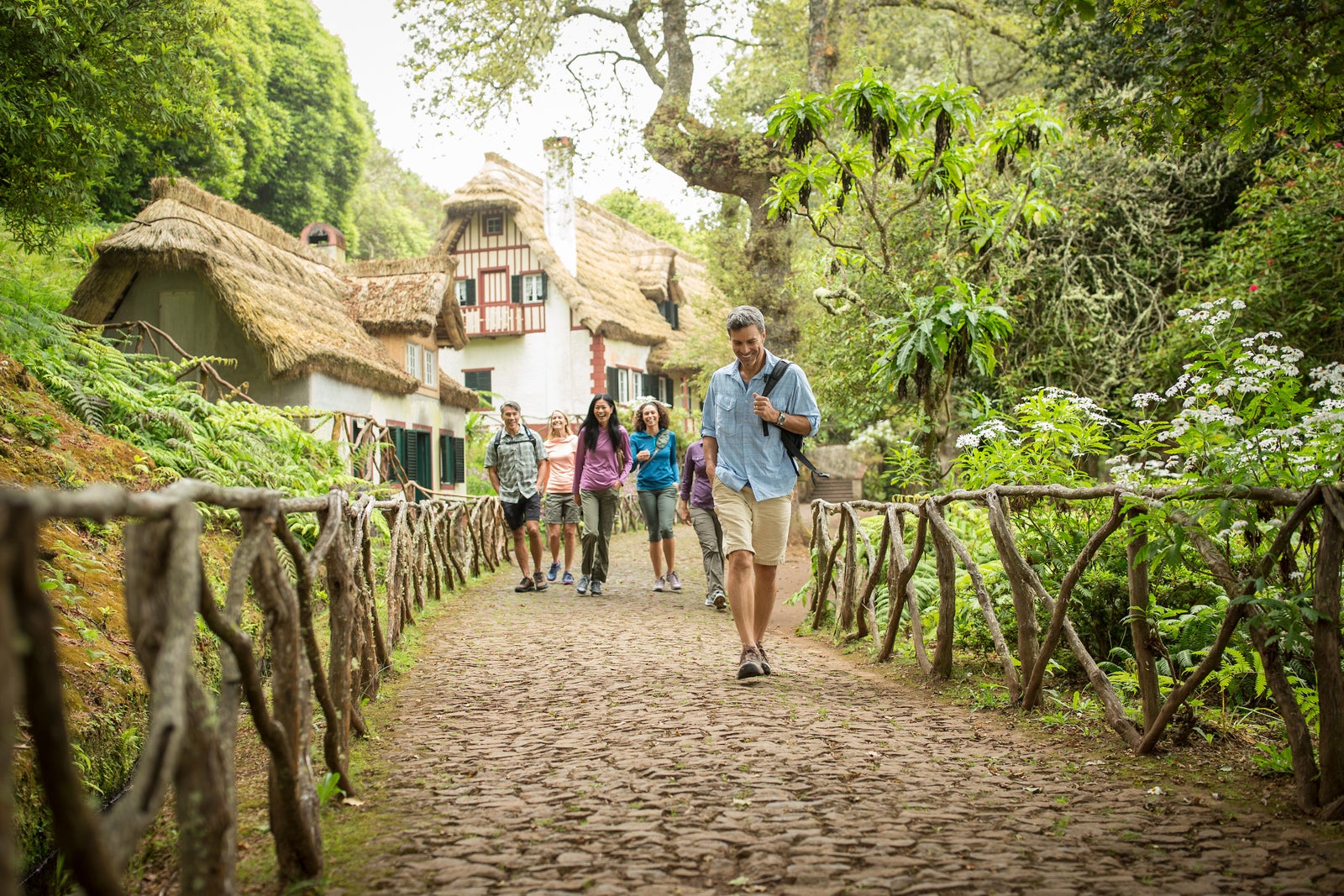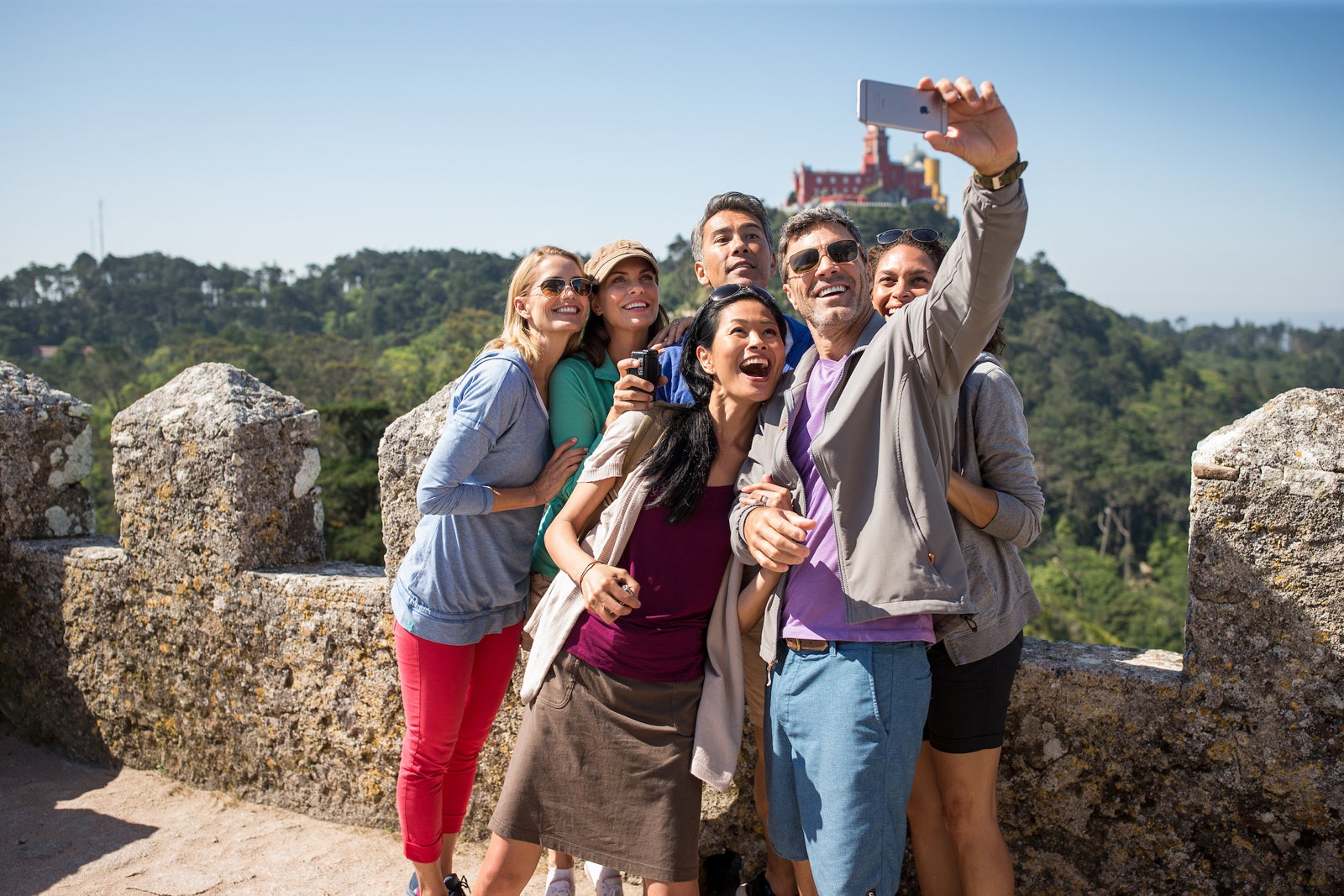Sometimes, you just want to leave the vacation planning to someone else.
Whether it’s an epic trip to America’s best-known national parks, a multiday visit to Paris and France’s chateaux country or an exploration of the Inca ruins of Peru, the most rewarding vacations also can be some of the hardest to plan.
Do you know enough about the places you want to visit to pick the best hotels in the best locations? Can you figure out the transportation to get from site to site? Do you even know which places you want to see?
And once you get there, who is going to explain it all to you?
Enter the escorted tour, also known as a group tour or guided tour — a trip where somebody else figures out many, if not most, of the little (and big) things that make a dream vacation come true.
If you think this means a tour on a full-size motorcoach — a “bus tour,” as some people call them — sure, that’s one type of escorted tour. But there are lots of other types of escorted tours out there that use all sorts of transportation, including trains and ships, and with varying levels of guiding, luxury and adventurousness, as well as group sizes.
There are also tours available that don’t involve traveling with a group at all. These are known as private tours.
Here is a guide to everything you need to know about tours in all their forms.
What is a tour?
Simply put, a tour is a vacation that somebody else has planned for you to make it as easy (and rewarding) as can be.

Reward your inbox with the TPG Daily newsletter
Join over 700,000 readers for breaking news, in-depth guides and exclusive deals from TPG’s experts
In many cases, these are guided trips done with a group of like-minded people — often called a group tour, escorted tour or guided tour. But not every tour that you’ll find available to book involves traveling with a group. In addition to group tours, some tour companies offer private tours — expertly planned trips led by a dedicated guide just for you.
There also are “independent tours” and city stays where a tour company has arranged many of the elements of your trip — your lodging, airport transfers, transportation between cities and some sightseeing, for instance — but mostly leaves you to explore each destination on your own.
What all of these forms of tours have in common is that they are designed to alleviate many of the pain points that occur during the trip’s planning process and also during the trip itself.

Types of tours
Years ago, many group tours took place on large motorcoaches with relatively large groups and involved fast-paced travel between lots of sites. There still are group tours like that, in part because they remain popular. If your aim is to see a lot of a country, region, city or natural area in a limited amount of time at an affordable price and with an expert guide who will tell you more about what you’re seeing than you ever could have learned on your own, it’s hard to beat a classic motorcoach tour.
But these days, there are far more options when it comes to touring, including tours designed for all sorts of group sizes, at all sorts of luxury and adventure levels, as well as with all sorts of transportation types. Additionally, you’ll find tours that cater to a wide range of travelers, from solos and families to retirees, and to a wide range of traveler interests. There are specific tours for foodies, for wine lovers and for photography fans, for instance. Other tours focus on art sites or religious sites.
Even when looking at options at individual tour companies, you’ll now often find a relatively wide range of options for each of the main tour destinations — everything from relatively quick, fast-paced trips with lots of sightseeing to itineraries that are longer and more go-slow in their approach, with more free time built into the schedule, as well as more choice in activities.
Some of the biggest and best-known tour companies catering to North Americans, such as Globus, offer all (or most) of the types of tours mentioned above, with a menu of different types of tours available to suit almost every taste.
By way of example, here’s a look at all the different types of tours offered by Globus — 10 in all:
- Classic tours. These are group tours guided by an expert, with Globus arranging almost every aspect of the trip — hotels, airport transfers, transportation between sites, many meals, attraction tickets and more — to create a carefully curated and stress-free experience where you basically just have to show up and have a great time. Often, these tours involve travel between cities and sites on a motorcoach that can seat more than 50 people (although, typically, Globus never puts more than 45 people at a time on these tours, leaving some seats on the bus open; the average group size is 36 people). But Globus also offers what it calls “Small Group Departures” for three-quarters of its Classic tours that involve travel in a smaller group (the average is 24 people).
- Small-group discovery tours. These are group tours designed for travelers who prefer a more intimately sized group and are willing to pay a little more for the privilege. Also guided by an expert, they feature an average group size of just 15 people for tours in Europe, with trips elsewhere averaging 18 people. They also often include activities that can only be done in smaller groups, such as private wine tastings, cooking classes, art classes and visits to lesser-known sites that are difficult to visit in bigger groups. Additionally, they sometimes include stays at unique, smaller accommodations.
- Independent tours and city stays. These are “do-it-yourself” tours and city stays where Globus arranges many of the key elements of your trip — your hotel, airport transfers, transportation between cities (if needed) and some basic sightseeing — but mostly leaves you alone to explore each destination on your own. They are not group tours. You’re traveling on your own. But in addition to letting Globus make all the basic arrangements for you, you’ll typically have access to local hosts, often based at your hotels, who can help you with ideas on what to do in each place you visit and solve any problems that arise. Globus bills it as a “freedom with a safety net” sort of travel.
- Undiscovered tours. These are group tours designed to take travelers beyond the main tourist destinations and sites in countries to lesser-known and less-crowded places, often with an emphasis on off-the-beaten-path places known mostly to locals. A “Hidden Gems of Southern Italy” tour, for instance, brings travelers to small towns in the little-visited Apulia region in the “heel” of Italy. Other Undiscovered tours focus on the Scottish Highlands and Balkan countries such as Albania and Montenegro.
- Escapes tours. These are group tours that take place during the offseason in popular destinations, offering a chance to travel when crowds are smaller, lines are shorter and, in the case of many European tours, temperatures are milder. They’re also typically priced lower than tours during the peak season — as much as 30% lower.
- Religious tours. Also called faith-based tours, these Europe- and Middle East-focused group trips are aimed at travelers who want to make a pilgrimage to sacred locations of Christianity, particularly the Holy Land.
- Rail tours. These group tours include rail travel as part of the experience, often in addition to traditional motorcoach touring. A seven-day “Best of Norway” tour, for instance, includes travel on the country’s iconic Flam railway, considered one of the world’s most scenic train rides. An eight-day “Peru Splendors” tour includes a rail trip to Machu Picchu.
- Cruise and tour vacations. These group tours to places like Egypt or Greece combine traditional touring by land with several days of travel by ship. Nine-day Egypt cruise and tour vacations, for instance, include four nights of travel on a Nile riverboat to see the ancient ruins of Luxor, the Valley of the Kings and other iconic sites.
- Special event tours. These group tours focus on iconic events such as the annual Rose Parade in Pasadena, California, the Albuquerque Balloon Fiesta in New Mexico and the New Year’s Eve fireworks over the harbor of Sydney. For travelers who’ve always wanted to see these events, Globus has designed tours that include special access where you don’t have to plan a thing.
- Private tours. These tours offer all the benefits of one of Globus’ group tours, except that you don’t have to share the trip with anyone else except your hand-picked traveling party. For a higher cost than the typical Globus tour, you get a guided tour experience just for you and your traveling companions.
We used Globus as an example here, as it has one of the broadest arrays of tour styles of any brand, but other tour companies also often offer a selection of tour types. Upscale tour operator Tauck, for instance, offers both larger and smaller group tours, special tour departures aimed at families, rail-focused tours that it calls “Train Journeys” and other sub-types of tours, including trips that include cruise travel.

What are the advantages of a tour?
Perhaps the biggest advantage of signing up for a tour is that it makes planning (and taking) a vacation easy … and that’s no small thing. As anyone who has planned a significant vacation knows, there can be a lot of moving parts, and the process can be stressful.
Whether you want to visit cities, the countryside or natural wonders in your own country or in countries halfway around the world, finding just the right lodging for each night of your trip, arranging transportation between the places you plan to visit, picking specific sites to see and lining up local tours and guides can be complicated and time-consuming, as well as rife with the opportunity to make mistakes. Once you’re on your trip, the do-it-yourself approach can often lead to disappointment when things don’t go as planned.
While some people love to arrange do-it-yourself vacations, others find that being your own tour leader can take the joy out of travel.
On a tour, you never have to worry about getting from point A to point B, where to sleep or what to see. In signing up for a tour arranged by someone else, you are also taking the hassle out of figuring out local customs and currency, so you just enjoy the ride.
Specifically, tours in most of their forms get you:
- An expert guide. On most tours, you’ll have an expert guide or tour leader with you at all times who is there to explain what you’re seeing and help put it in context. When traveling in foreign countries, this guide can also serve as a translator at times (of both the language and the culture) and as an adviser on everything from tipping customs to fair pricing for local goods.
- Simplified travel. Your tour company will typically take care of all the logistics that are involved with travel, from booking your hotel to arranging all your transportation and activities. You just relax and enjoy the journey.
- A built-in set of travel companions. A key thing about group travel is that … it’s a group. You’ll be sharing your trip with at least a few, if not a few dozen, like-minded people who can contribute to a richer travel experience. This is something that often appeals to travelers who like to be social when they travel, particularly solo travelers (not that you have to interact all that much with your fellow tourgoers if you don’t want to; it’s entirely up to you).
Additionally, tours also can be a more affordable choice when booking a trip (more on this below).
All that said, there are some things to consider when booking a tour. If traveling as part of a group is just not your thing, you may want to focus on one of the independent tours that some companies offer — the ones where the tour company arranges a lot of the pieces of your trip but then lets you experience the trip on your own.
You also need to think about how much you like or dislike travel that follows a set itinerary — and how set you would prefer that itinerary to be. Most tours have some flexibility built into the schedule — an afternoon free during a city visit or a choice of activities on certain days. But in broad strokes, the idea of a tour is that you are signing on to tag along on what is a very well-thought-out schedule of sightseeing and activities to make the most of your travel days.
You’ll likely see more and do more on a group tour than you would if you had organized your trip on your own. But the trade-off is that, for the most part, you’re along for the ride for what the group is scheduled to do and might not have a lot of time to venture out by yourself.

Where can I go on a tour?
In short, you can go just about anywhere.
Many of the biggest tour companies catering to North Americans offer a broad range of trips all over the world, from the Americas to Asia.
Trips to Europe often represent the biggest category of departures for big tour companies serving North Americans, as it’s one of the most popular places for Americans to take tours. But most major tour companies that cater to North Americans also typically offer large numbers of tours across North America, as well as at least some tours to South America, Asia, Africa, Australia and the rest of the Oceania region.
Tour giant Trafalgar, for instance, operates 149 itineraries in Europe and 68 itineraries in North America, according to tour booking site TourRadar. It operates another 24 itineraries in Asia, 17 in Latin America and 19 in the Oceania region.
For Europe tours, in particular, you’ll often find large numbers of options not just for the region as a whole but for individual countries. As of the time this guide was published, Globus offered 30 different tour itineraries that either focused entirely or significantly on Italy. There were 19 distinct itineraries listed for France.
Italy, France and England are the three places in Europe where you’ll typically find the most variation in tours available. But tours to Germany, Austria, Hungary, Greece and the Netherlands also are common.

Beyond Europe, tours to America’s national parks are also a common theme across the industry, as are tours to America’s most famous historic sites (Civil War battlefields, for instance) and cities. In North America, you’ll also find tours to scenic areas such as New England and the Hudson Valley and to specific bucket-list destinations such as Hawaii.
Tours to South America often revolve around visits to iconic sites, such as Machu Picchu and the Sacred Valley in Peru; the massive Iguazu Falls on the border between Argentina and Brazil; the Amazon rainforest; and the Galapagos Islands.
Tours to Asia often focus on Japan, China, India, Thailand and Vietnam. You’ll find tours that will take you to, say, the Great Wall of China or the Forbidden City of Beijing; Japan’s capital, Tokyo, and the historic city of Kyoto; and the “Golden Triangle” of India.
Tours to Africa often revolve around immersive safari experiences — tours to East Africa’s game reserves in Tanzania and Kenya are a popular option — as well as famed natural wonders such as Victoria Falls and the Zambezi River. Tours that include visits to Cape Town and Johannesburg in South Africa are common. But perhaps the biggest destination for tours in Africa is Egypt (specifically, the Nile), where tours focus on the wonders of ancient Egypt, including the Pyramids of Giza, the Valley of the Kings and the temples of Luxor and Karnak.
In many of these regions, you’ll also find tours not just to classic destinations but lesser-visited destinations, too, such as single-country explorations of, say, South Korea, Georgia or Armenia — places that can sometimes be easier to see as part of an organized group tour than on a do-it-yourself trip.

Which companies offer tours?
The tour business is a relatively fragmented business, with dozens of brands that offer tours.
Notable tour companies marketing to North Americans include:
- Abercrombie & Kent
- AdventureWomen
- Adventures by Disney
- Brendan Tours
- CIE Tours
- Collette
- Contiki Tours
- Cosmos
- G Adventures
- Gate 1 Travel
- Globus
- Grand Circle Travel
- Intrepid Travel
- National Geographic Expeditions
- Overseas Adventure Travel
- Road Scholar
- Tauck
- Trafalgar
While marketed separately, some of these brands are related to each other as sister companies operating under the same corporate umbrella.
Globus and Cosmos, along with river cruise line Avalon Waterways, for instance, are all part of the Globus family of brands, which collectively is one of the world’s biggest tour operators. The three brands under this umbrella together offer more than 500 itineraries across 80-plus countries, with more than 10,000 individual departures.
Another major group of tour operators is The Travel Corporation family of brands, which includes the company’s flagship brand Trafalgar, as well as Brendan Tours, Insight Vacations, Contiki Tours, Luxury Gold, Costsaver and river cruise line Uniworld.
The Travel Corporation’s brands collectively offer more than 750 itineraries across 70-plus countries, with more than 2,000 individual departures.
Each of these big tour operator groups has member brands that target a different demographic or traveler interest.
Globus tours, for instance, are somewhat higher priced and offer more inclusions than the tours offered by sister brand Cosmos. The company’s Avalon Waterways division focuses exclusively on tours that include river ship travel.
Among The Travel Corporation brands, Trafalgar caters to a wide range of demographics, while Contiki Tours is exclusively for younger travelers in the 18- to 35-year-old age range. The company’s Brendan Tours division is even more narrowly focused, with trips to only two places in the world: Ireland and Scotland. The company’s Luxury Gold brand focuses on high-priced tours, while its Costsaver brand offers, as you might expect from the name, budget-style trips.
Among the other brands listed above, a few (such as Tauck and Abercrombie & Kent) have carved out a niche focusing on higher-end (and higher-priced) tours. Adventures by Disney — a division of resort and entertainment giant The Walt Disney Company — is aimed specifically at the family market with more than 40 family-friendly itineraries, while AdventureWomen caters exclusively to women travelers with several dozen women-only trips a year.
Among the rest, Overseas Adventure Travel specifically offers tours for travelers ages 50 and up. It’s part of another group of affiliated tour companies that also includes Grand Circle Travel and Grand Circle Cruise Line — all aimed at the 50-plus crowd. CIE Tours is particularly known for tours around Ireland, including two new walking and hiking tours through the country.
National Geographic Expeditions (which, like Adventures by Disney, is now affiliated with The Walt Disney Company) focuses on tours that take in natural wonders, archaeological sites and wildlife-rich destinations. G Adventures is particularly focused on adventurous travel.

How long are tours?
How long do you want to be away on vacation? Whether it’s just a few days or many weeks, there’s likely a tour available for you. Many of the biggest tour companies offer a wide range of tour lengths. You’ll find a lot of tours that last around seven days, which are designed to work well for travelers who are still working and can only get away from work for a week. But many companies also offer longer 10-night to two-week tours, and there are tours that last a month or longer — the latter typically aimed at retirees who have more time for travel.
Tour company Road Scholar, which draws a lot of retirees, for instance, has trips as long as 135 days on its schedule. Other companies, such as Collette Tours, mostly stick to trips ranging from seven to 14 days in length but offer a smattering of longer itineraries. Of 186 tours on offer via Collette’s website, 26 are longer than two weeks in length, including a 19-day New Zealand itinerary and a 27-day tour across the South Pacific.
Longer tours are most common for destinations that involve long-distance travel for Americans, such as Australia, New Zealand, Asia and the South Pacific. Complex itineraries that cover a broader area or multiple countries also often are longer in general.
You’ll also find that tours that promise a more relaxed pace will often be longer.

How much do tours cost?
Tour costs vary widely, with some available for as little as $1,000 per person while others cost as much as $10,000 per person or more.
As with any travel, longer trips tend to cost more. But there are a lot of other factors that affect the price of a tour, from the luxury level of the accommodations that are included with the tour to the general cost of travel in the destination that is the focus. Trips that include stays in pricey cities such as Tokyo, Zurich or Paris often come with premium pricing, as do trips to remote locations such as Antarctica or parts of Africa (where safari trips, in particular, can be very pricey).
Other factors that affect tour cost include the number of meals and activities covered during the tour and the size of the group. Notably, small-group tours generally cost more than larger group tours, and private tours generally cost even more.
The timing of any given tour is also a factor, with tours departing during high-season periods often costing significantly more than tours departing during offseason periods.
For example, as of this guide’s publication, September 2026 departures of a six-night “Bonnie Scotland” tour of Scotland offered by Globus were available starting at $2,399 per person — or about $400 per night. But the same tour scheduled for August 2026 started at $3,079 per person — or about $500 per night.

The only difference between the trips is that August is the high season for travel in Scotland, when demand is highest, and September is a slower season for travel to Scotland. Just by waiting a few weeks to take this tour, you could save more than 20%.
For even more savings, Globus also offers five-night “Scottish Highland Escape” tours to Scotland during the deeply offseason period of January to March that start at just $1,169 per person — or about $234 per night. Part of the brand’s Escapes line of lower-cost offseason tours, these trips are slightly shorter than the “Bonnie Scotland” trips but offer much of the same sightseeing.
When considering such trips, just remember that the offseason is often the offseason for a reason. The weather in Scotland from January to March is significantly colder than during the summer months and can be wet and rainy, which can affect your touring experience. On the flip side, if you sign up for a tour of Scotland during the winter months, you’ll find normally crowded attractions, such as the iconic castle of Edinburgh or the battlefield of Culloden, blissfully free of crowds.
Are tours a good value?
When evaluating the cost of a tour, it’s important to keep in mind that the price includes many things that you’d typically pay for separately if you were booking a trip on your own. An upfront cost of $400 or $500 per person, per day for a tour may seem like a lot, but it can represent a significant value when you consider the individual costs of all the elements that you are getting bundled into the price.
In addition to accommodations each night, the pricing of a tour often folds in quite a few meals, transportation from place to place (no need to pay for a rental car, Ubers, taxis or trains) and, perhaps most notably, an extensive amount of guided touring with most or all admission costs to attractions included.
The latter is no small thing, given how much the cost of guided touring and admissions to attractions can be at a destination if you book and pay for it all on your own.
Additionally, for many people and maybe you, there is an intangible value to signing up for a tour related to the time it saves in travel planning. How many hours would you spend trying to arrange a trip with so many moving parts on your own? What is your time worth? And, given that you’re probably not an expert in the history and sites of the places that you plan to see on the trip, nor the transportation system or lodging options at these places, what are the odds that you’ll get the planning right?
Similarly, there is an intangible value to having an expert guide leading you on such a trip versus traveling to the same place on your own. On a group tour, the sights often come to life with the stories you get about the places you are visiting from the guide. It can be a deeper immersion and connection than you’d get on your own.
There’s no hard dollar number for those last two factors, but they may be the biggest value components of a tour.

Bottom line
There are many reasons to sign up for a multiday tour instead of making all the travel arrangements on your own when planning a trip to a destination. For starters, it makes the planning part of the trip easy. It also simplifies the travel experience once you’re at your destination.
In many cases, your tour company will arrange every piece of your trip, from the hotel you stay in and many of the restaurants where you will eat to your transportation and sightseeing tickets, as well as local guides. All you have to do is show up.
That can mean you have more time on your trip to focus on the things that you are seeing and doing, not the logistics of the trip.
If this sounds appealing to you, you’ll find a wide range of tour companies offering journeys for just about every type of traveler.
